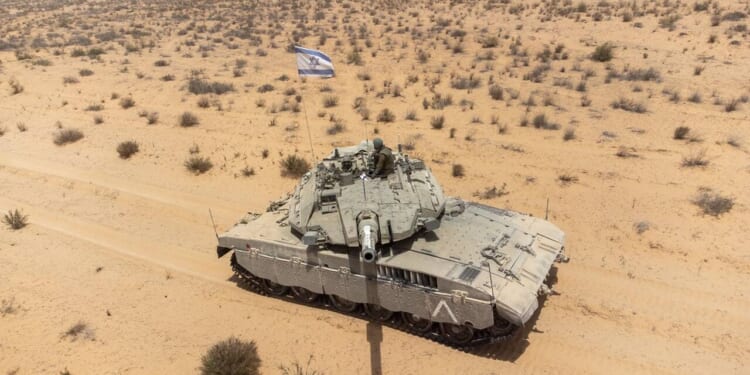The Merkava is an excellent tank, but it must be shepherded carefully. They are not mythical invincible beasts—especially in urban warfare.
At around the time that the ceasefire between Hamas and Israel was first announced by President Donald Trump, many news media outlets in the West showed images of Israel’s Merkava Mk. 4 main battle tanks (MBTs) in Gaza, firing into crowds. The implication of the footage was that the Israelis had violated the ceasefire only minutes after it had entered into effect. In fact, it has since been determined that the videos of the tanks were taken just before the ceasefire was announced.
Though the narrative surrounding the footage was inaccurate, it highlights a greater concern among many Western observers that neither the Israelis nor Hamas will ultimately respect the ceasefire. Indeed, there are already hints that both sides are attempting to outmaneuver each other under very thin diplomatic cover. But the sight of imposing Merkava MBTs sitting before crowds of Palestinian refugees streaming into the Gaza Strip is especially caustic.
What to Know About Israel’s Merkava Tank
- Year Introduced: 1979 (continuous upgrades since)
- Number Built: ~2,000, all variants; 300 Mk IV units under delivery
- Length: 9.04 m (29.7 ft)
- Total weight, battle ready: 65 tonnes (143,000 lb)
- Suspension: Helical spring suspension
- Engine: Depends on variant; generally 1,119 kW turbocharged diesel engine
- Armament: Two 7.62mm turret machine guns; one 60mm mortar; one .50 caliber machine gun within turret
- Older variants (Mk I and Mk II): 105mm smoothbore cannon
- Newer variants (Mk III and Mk IV): 120mm smoothbore cannon
- Top speed: 64 km/h (40 mph) on road; 55 km/h (34 mph) off road
- Range: ~500 km (310 mi)
- Crew: 4 (commander, driver, gunner, loader)
The Merkava Mk 4, especially the “Barak” upgraded variant, is Israel’s premier main battle tank. It features a 120mm smoothbore gun, a sophisticated fire-control system, modular composite armor, and Trophy active protection system (APS) to defend against anti-tank missiles, RPGs, and other threats. It has a 60mm internal mortar, machine guns, and night optical gear, thermal sights, and upgraded sensors for enhanced situational awareness that allow for these MBTs to operate on complex battlefields—including urban combat of the kind that defined the Gaza conflict.
Protection is designed with the crew’s survivability in mind. The Merkava unusually has its engine mounted in front of the turret, to add a buffer for the crew area. It also has heavier armor on vulnerable areas, and modular armor so upgrades and repairs are possible. The Israelis have recently added defensive measures to better respond to the growing threat that drones and magnet bombs pose to the tanks.
During Israel’s engagement in Gaza, Merkava MBTs were used in urban raids and to support infantry in densely built environments where ambushes, improvised explosive devices (IEDs), and anti-tank threats are constant. Their firepower is used to suppress fortified positions. Their armor and APS help them survive many of these threats.
Speaking of the anti-drone capabilities, Israel, like the Ukrainian and Russian Armed Forces fighting each other in Ukraine, have added anti-drone cages (or covers) to better defend against drones. Israeli engineers likewise added rubberized skirts or even armored skirts to reduce the risk of magnetized bombs. And the enhanced sensors mentioned above, along with more sophisticated computer systems, help to distribute key data and reduce crew workload—a key feature especially when engaged in battle.
Still, multiple Merkavas were destroyed in the campaign against Hamas in Gaza. There are reported cases of Merkava MBTs being destroyed or disabled by IEDs. In at least one instance, a Mk.4 Barak was destroyed by a massive IED in Gaza, with heavy crew casualties.
How Israel Plans to Keep the Merkava Relevant
Israel is allocating big money to accelerate production of the Merkava, as well as other related armored vehicles like the Namer APC. This suggests they see armored capability as central to their defense doctrine, not something to be placed on the backburner. Seeing Merkavas rolling deep into Gaza, surviving attempted Hamas strikes, and pushing advances sends a signal to Hamas and other regional actors about Israel’s willingness and capability to conduct ground operations, sustain them, absorb losses, and push forward.
Then again, MBTs might not be the best suited for counterinsurgency operations. And no matter how many adaptations are made to the tanks, they are an odd fit for urban warfare. Heavy reliance on armor risks logistics strain, overexposure, political backlash if civilians are harmed, and risk of adversary innovation catching up. There’s always arms versus tactics versus political awareness.
So, the Merkava is an excellent tank, but even it must be shepherded carefully. They are not mythical invincible beasts—especially in urban warfare. Yet they are among the most capable armored vehicles in this kind of asymmetric, urban combat. What matters more than raw specs is how Israel uses them: in combination with infantry, intelligence, engineering, adaptation, and political will. Their performance in Gaza so far underscores both Israel’s industrial and military strength, and the limits imposed by terrain, adversary tactics, and war’s political costs.
About the Author: Brandon J. Weichert
Brandon J. Weichert is a senior national security editor at The National Interest. Recently, Weichert became the host of The National Security Hour on America Outloud News and iHeartRadio, where he discusses national security policy every Wednesday at 8pm Eastern. He is also a contributor at Popular Mechanics and has consulted regularly with various government institutions and private organizations on geopolitical issues. Weichert’s writings have appeared in multiple publications, including The Washington Times, National Review, The American Spectator, MSN, The Asia Times, and others. His books include Winning Space: How America Remains a Superpower, Biohacked: China’s Race to Control Life, and The Shadow War: Iran’s Quest for Supremacy. His newest book, A Disaster of Our Own Making: How the West Lost Ukraine is available for purchase wherever books are sold. He can be followed via Twitter @WeTheBrandon.
Image: Shutterstock / Ran Zisovitch.

















